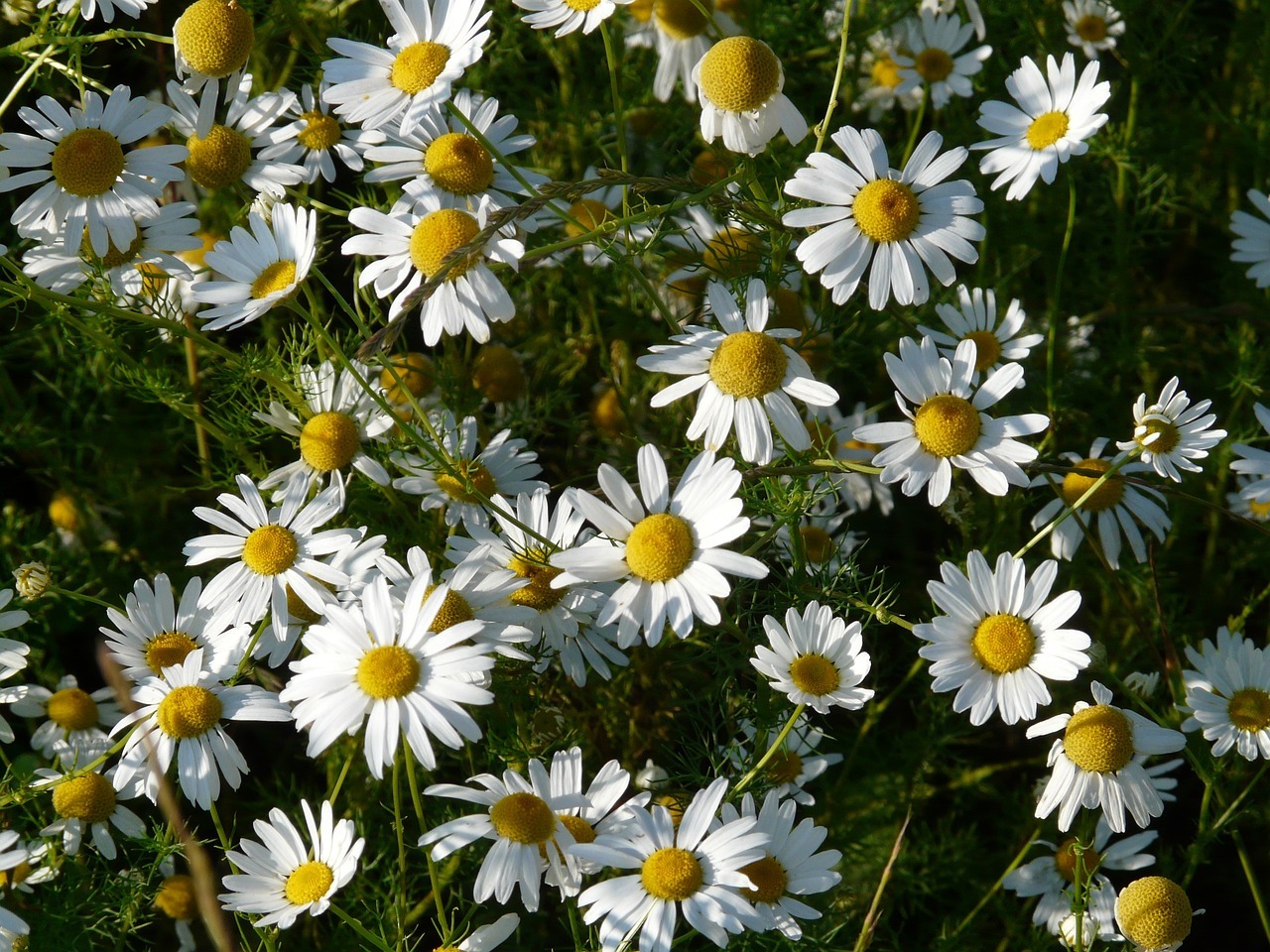Chamomile (Matricaria chamomilla) Health Benefits and Herbal Uses

Chamomile, scientifically known as Matricaria chamomilla and also referred to as German chamomile, is a well-known plant belonging to the Asteraceae family. It’s an annual herb native to Africa and worldwide. Chamomile is commonly used to make herbal tea and has been traditionally used in medicine for various purposes. It’s often used in traditional medicine for conditions like cramps and sleep disorders related to premenstrual syndrome. The flowers contain essential oil with chamazulene, giving them a characteristic blue colour and fragrance.
Health benefits of Chamomile (Matricaria chamomilla)
Chamomile (Matricaria chamomilla), also known as German chamomile, is renowned for its health benefits. Here are some of the key benefits supported by research:
- May Improve Sleep Quality:
- Chamomile contains apigenin, an antioxidant that binds to brain receptors, potentially promoting sleepiness and reducing insomnia.
- Drinking chamomile tea has been associated with improved sleep quality, especially in postpartum women and those with sleep disturbances.
- May Promote Digestive Health:
- Chamomile has anti-inflammatory properties that may help with digestive issues such as diarrhoea and may protect against stomach ulcers by reducing stomach acidity.
- It’s also used to soothe the stomach and is believed to be beneficial for conditions like heartburn and stress-related flatulence.
- Menstrual Pain Relief:
- The anti-inflammatory and antispasmodic properties of chamomile may alleviate premenstrual syndrome (PMS) symptoms, including cramps and anxiety.
- Diabetes Management:
- Some studies suggest chamomile tea can lower blood sugar in people with diabetes and improve glycemic and lipid profiles.
- Bone Health:
- Chamomile may have a role in preventing osteoporosis, as it has been shown to help maintain bone density in animal studies.
- Anti-Inflammatory Effects:
- Regular consumption of chamomile tea might reduce inflammation, which is linked to a variety of health issues.
- Cancer Prevention:
- Laboratory studies suggest that compounds in chamomile may help prevent the growth of certain types of cancer cells
The chemical properties of Chamomile (Matricaria chamomilla)
German chamomile has a rich profile of chemical constituents that contribute to its medicinal properties. Here are some of the key chemical components found in chamomile:
- Flavonoids: These include apigenin, luteolin, and quercetin. Flavonoids are known for their antioxidant properties and contribute to the anti-inflammatory and cancer-preventive effects of chamomile.
- Terpenoids: Among them, chamazulene and (-)-α-bisabolol are significant. Chamazulene gives chamomile its characteristic blue colour and has anti-inflammatory properties, while (-)-α-bisabolol is known for its soothing effect on the skin.
- Coumarins: These compounds have potential blood-thinning effects, which might be beneficial in preventing blood clots.
- Volatile Oils: The essential oil derived from chamomile flowers contains various compounds, including bisabolol oxides, bisabolone oxide, and spiroethers, which are thought to contribute to chamomile’s gastrointestinal benefits and sedative effects.
- Polysaccharides: These are complex carbohydrates that can support immune function.
- Organic Acids: These contribute to the plant’s therapeutic effects, including its anti-inflammatory and antimicrobial activities.
The combination of these compounds in chamomile provides a broad spectrum of pharmacological activities, including anti-inflammatory, anti-cancer, antithrombotic, antioxidant, hypolipidemic, hypoglycemic, antihypertensive, antidepressant, and neuroprotective effects. However, it’s important to note that while chamomile is widely used in traditional medicine and has shown promise in various studies, more research is needed to fully understand its effects and safety profile. Always consult with a healthcare provider before using chamomile for medicinal purposes.
How to use the Chamomile (Matricaria chamomilla) as medicine to treat illnesses
Chamomile (Matricaria chamomilla) has been used as a medicinal herb for centuries, and it offers several potential health benefits. Here are some ways to use chamomile for various purposes:
- Chamomile Tea:
- Insomnia and Sleep Disorders: Chamomile tea is well-known for its mild sedative effects. It may help improve sleep quality and ease insomnia. You can brew chamomile tea by steeping dried chamomile flowers in hot water.
- Anxiety and Stress: Drinking chamomile tea may help reduce anxiety and promote relaxation.
- Topical Applications:
- Skin Irritations: Chamomile can soothe skin rashes, including conditions like eczema. You can apply chamomile-infused creams or ointments to affected areas.
- Minor Burns and Sunburn: Chamomile’s anti-inflammatory properties make it useful for treating minor burns and sunburn. Apply cooled chamomile tea or chamomile-infused oil to the affected skin.
- Mouth Rinses:
- Mouth Sores and Gum Health: Chamomile mouth rinses can help heal mouth sores and prevent gum disease. Gargle with cooled chamomile tea for relief.
- Eye Compresses:
- Eye Inflammation and Infections: Use chamomile-infused warm compresses to soothe eye irritation and inflammation.
- Menstrual Cramps:
- Chamomile may help reduce menstrual cramps. You can drink chamomile tea during your menstrual cycle.
- Caution and Precautions:
- Pregnancy and Breastfeeding: Chamomile hasn’t been proven safe during pregnancy or breastfeeding, so consult your healthcare provider before using it.
- Allergies: Some individuals may be allergic to chamomile. If you experience any adverse reactions, discontinue use.
- Interactions: Always check for potential interactions with other medications or supplements you’re taking.
Remember that individual responses to chamomile can vary, and it’s essential to consult with a healthcare professional before using it as a treatment.
Safety and Side Effects:
-
- Chamomile is generally considered safe, but there are potential side effects:
- Allergic Reactions: Some individuals may experience allergic eczema or eye irritation from skin creams containing chamomile.
- Drowsiness: Chamomile can cause drowsiness, especially when combined with other sedatives.
- Nausea or Vomiting: Large doses of chamomile may lead to nausea or vomiting.
- Interaction with Birth Control Pills: Chamomile might make birth control pills less effective.
- Chamomile is generally considered safe, but there are potential side effects:
Precautions:
-
- If you have a history of cancer, endometriosis, or uterine fibroids, consult a healthcare provider before using chamomile.
- Pregnant individuals should avoid chamomile.
- Always ask your paediatrician before giving chamomile to infants or children.
Remember to consult your doctor before using chamomile, especially if you have any health conditions or take other medications
External links
side effects of Chamomile (Matricaria chamomilla)
How to use the Chamomile (Matricaria chamomilla)

